Boat_mare
Cadet
- Joined
- Feb 1, 2022
- Messages
- 7
hi memboaters,
New to boat building/boat works and new to the site so you might get a few questions and think ‘not another one’, but give me a break and some advice at the same time lol
I’m not stupid and pick up things very quickly which is probably good considering I decided to snatch up a hull for almost nothing that needs pretty much everything apart from the fiberglass body!
Anyway I know what I’m in for but so far I’ve got a few issues beating on my brain that I need to answer before I fully remove her bones.
So I’m not sure what year she is but I think she’s 1992 bayliner Capri 17ft
I have her supported on the keel and chines. I am sure that the supporting method I have is sufficient to support weight no problem but does anyone see any issue with removing the guts (stringers/bulkheads/transom) and replacing while cradled in this way?
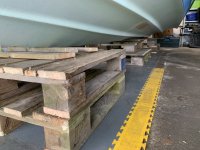
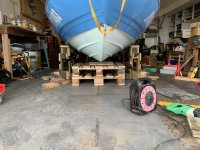
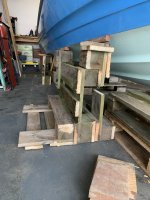
I have stripped out her deck and bow seats etc and she is down to stringers and the bulkheads which are surprisingly still there although im unsure if one is missing. Should there be a bulkhead/bulkheads central or toward the bow as there was only the two at the stern end.
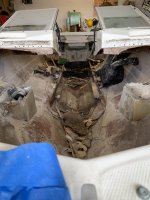
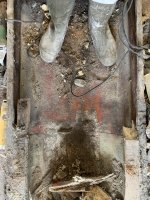
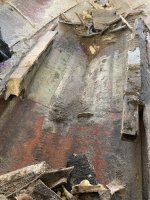
It looks like there have been a few half arsed repairs on the boat already (like the wood tabbed to the stringers that have compressed/collapsed) but im hoping she’s still straight. Would I be able to figure this out by stringing a center line and then measuring to points either side to see if measurements match up (effectively meaning balanced, if the measurements don’t match then the body is warped already?) I don’t want to lock her in a twist!
My next issue is removing the transom which tucks up behind the ‘splashwell’.
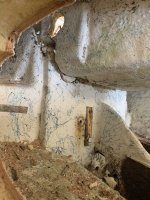
I have come to the conclusion that I don’t want to remove the cap from the lower hull. So I plan to cut out a section of the splash well in order to be able to access the transom without de-capping. My questions here are:
exactly how should I cut it in order not to sacrifice strength to the top engine mount on the transom when rejoined?
Considering the engine weight/stress is, or should be on the transom core, does the location of the splashwell cut matter as the fiberglass that will be cut out is only realistically a cap for the top of the transom and obviously makes the back of the splashwell.
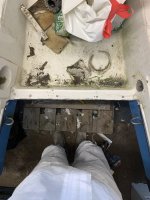
Hopefully you guys have some good words for me
New to boat building/boat works and new to the site so you might get a few questions and think ‘not another one’, but give me a break and some advice at the same time lol
I’m not stupid and pick up things very quickly which is probably good considering I decided to snatch up a hull for almost nothing that needs pretty much everything apart from the fiberglass body!
Anyway I know what I’m in for but so far I’ve got a few issues beating on my brain that I need to answer before I fully remove her bones.
So I’m not sure what year she is but I think she’s 1992 bayliner Capri 17ft
I have her supported on the keel and chines. I am sure that the supporting method I have is sufficient to support weight no problem but does anyone see any issue with removing the guts (stringers/bulkheads/transom) and replacing while cradled in this way?



I have stripped out her deck and bow seats etc and she is down to stringers and the bulkheads which are surprisingly still there although im unsure if one is missing. Should there be a bulkhead/bulkheads central or toward the bow as there was only the two at the stern end.



It looks like there have been a few half arsed repairs on the boat already (like the wood tabbed to the stringers that have compressed/collapsed) but im hoping she’s still straight. Would I be able to figure this out by stringing a center line and then measuring to points either side to see if measurements match up (effectively meaning balanced, if the measurements don’t match then the body is warped already?) I don’t want to lock her in a twist!
My next issue is removing the transom which tucks up behind the ‘splashwell’.

I have come to the conclusion that I don’t want to remove the cap from the lower hull. So I plan to cut out a section of the splash well in order to be able to access the transom without de-capping. My questions here are:
exactly how should I cut it in order not to sacrifice strength to the top engine mount on the transom when rejoined?
Considering the engine weight/stress is, or should be on the transom core, does the location of the splashwell cut matter as the fiberglass that will be cut out is only realistically a cap for the top of the transom and obviously makes the back of the splashwell.

Hopefully you guys have some good words for me



















